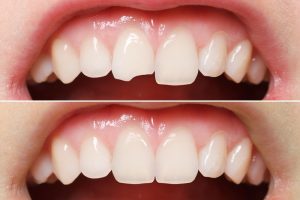
A bright, confident smile is an invaluable asset that can boost your self-esteem and leave a lasting impression. However, imperfections like chips, cracks, discoloration, or irregularities can dampen your smile’s radiance. Dental bonding is a popular cosmetic dentistry procedure that offers a swift and effective solution to enhance your smile. In this blog post, we’ll delve into what dental bonding is, the benefits it offers, the procedure involved, aftercare tips, and who can benefit from this transformative treatment.
[ez-toc]
Also Read: Dental Implants: A Comprehensive Guide to a Lasting Smile
Unveiling Dental Bonding
What is Dental Bonding? Dental bonding, also known as tooth bonding, is a cosmetic dental procedure where a tooth-colored resin material is applied to the teeth and then shaped and polished to match the surrounding teeth. It’s a versatile solution to fix minor imperfections and improve the overall appearance of teeth.
Benefits of Dental Bonding:
- Cosmetic Enhancement: Dental bonding can address chips, cracks, discoloration, gaps, and misshapen teeth, instantly enhancing your smile.
- Minimally Invasive: The procedure is non-invasive and typically requires little to no removal of tooth enamel.
- Fast Results: Bonding is often completed in a single visit, providing immediate improvements to your smile.
- Affordable: Compared to other cosmetic dentistry options, dental bonding is a cost-effective way to achieve a more appealing smile.
The Dental Bonding Procedure
1. Consultation and Planning:
- Your dentist will conduct a comprehensive examination and discuss your goals to determine if dental bonding is the right option for you.
2. Preparation:
- Little to no preparation is usually required. Anesthesia is typically not necessary unless bonding is being used to fill a cavity.
3. Bonding Application:
- The dentist will apply the tooth-colored resin material to the prepared tooth, carefully molding and shaping it to achieve the desired appearance.
4. Bonding and Shaping:
- The resin is shaped and smoothed to blend seamlessly with your natural teeth, ensuring a natural look and feel.
5. Curing and Polishing:
- A special light is used to harden the resin. Once hardened, the bonded tooth is further refined and polished for a smooth finish.
Aftercare Tips for Dental Bonding
- Oral Hygiene:
- Maintain good oral hygiene by brushing and flossing regularly to prevent staining and decay.
- Dietary Considerations:
- Avoid consuming foods and beverages that may stain the bonding material, such as coffee, tea, and red wine.
- Avoid Chewing on Hard Objects:
- Refrain from chewing on ice, pens, or other hard objects to prevent damage to the bonding.
- Regular Dental Check-ups:
- Visit your dentist for routine check-ups and cleanings to monitor the condition of the bonding and ensure its longevity.
Who Can Benefit from Dental Bonding?
Dental bonding is an excellent option for individuals who have:
- Minor cosmetic flaws such as chipped or discolored teeth.
- Small gaps or irregularly shaped teeth that they wish to enhance.
- A desire for a quick and affordable smile makeover without invasive procedures.
How Long Does Dental Bonding Last
Dental bonding, a cosmetic dental procedure where a tooth-colored resin material is applied and hardened with a special light, typically lasts between 5 to 10 years. However, the exact duration can vary based on several factors:
Oral Hygiene:
Maintaining good oral hygiene with regular brushing, flossing, and routine dental check-ups can help prolong the lifespan of dental bonding.
Diet and Habits:
Avoiding habits that could potentially damage the bonding, such as biting on hard objects or chewing on ice, can extend its longevity.
Material Quality:
The quality of the bonding material used and the skill of the dentist in applying and shaping it can influence how long the bonding lasts.
Location of the Bonding:
Bonding on teeth that experience less force and wear, such as those in the front of the mouth, may last longer compared to bonding on molars.
Chewing and Biting Habits:
Excessive pressure from grinding or clenching the teeth (bruxism) can wear down the bonding material faster.
Staining and Discoloration:
Certain foods, drinks, and smoking can cause staining or discoloration of the bonding, affecting its aesthetic appeal over time.
Age and Condition of the Bonding:
Older or deteriorating bonding may require repair or replacement sooner than newer bonding.
Dental Maintenance:
Regular visits to the dentist for check-ups and cleanings can help detect any issues with the bonding early, allowing for timely repairs or replacements.
It’s important to remember that dental bonding is a cosmetic procedure, and while it’s relatively durable, it may require maintenance or touch-ups over time. If you notice any chips, cracks, or changes in the bonding’s appearance or if it becomes uncomfortable or loose, it’s crucial to consult your dentist promptly for evaluation and necessary adjustments.
Your dentist can provide personalized guidance on caring for your dental bonding and how to maximize its lifespan based on your specific circumstances and oral health.
Conclusion
Dental bonding offers a remarkable way to transform your smile quickly and affordably. If you’re seeking a non-invasive and effective cosmetic dentistry solution, consult with your dentist to explore the benefits of dental bonding. Embrace the opportunity to rejuvenate your smile and rediscover your confidence through this simple and convenient cosmetic procedure. Smile brighter with dental bonding!